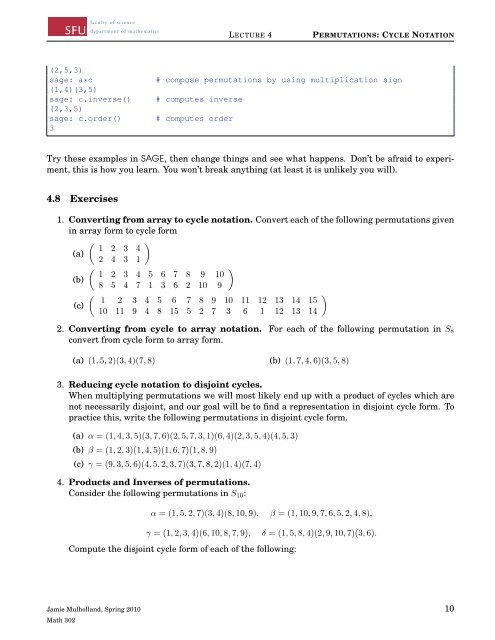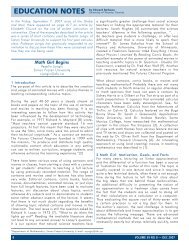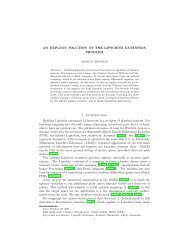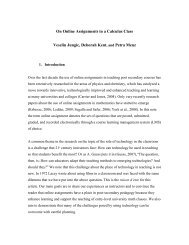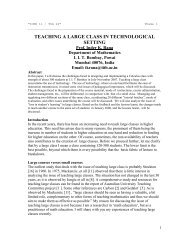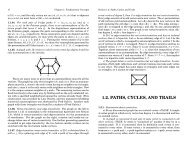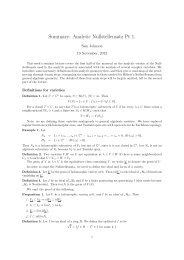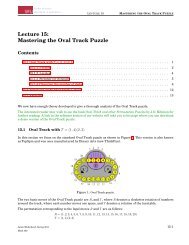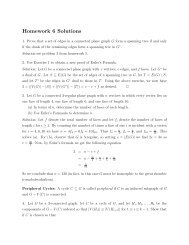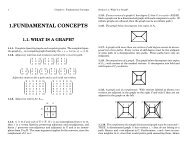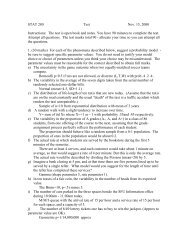Lecture 4: Permutations: Cycle Notation - People.stat.sfu.ca
Lecture 4: Permutations: Cycle Notation - People.stat.sfu.ca
Lecture 4: Permutations: Cycle Notation - People.stat.sfu.ca
Create successful ePaper yourself
Turn your PDF publications into a flip-book with our unique Google optimized e-Paper software.
Week Date Sections<br />
from FS2009<br />
5 Oct 5 III.1, III.2<br />
Part/ References Topic/Sections Notes/Speaker<br />
Combinatorial<br />
parameters<br />
FS A.III<br />
(self-study)<br />
Combinatorial<br />
Parameters<br />
6 12 IV.1, IV.2 Multivariable GFs<br />
Asst #1 Due<br />
7 19 IV.3, IV.4 Analytic Methods Complex Analysis<br />
8<br />
9<br />
26<br />
Nov 2<br />
IV.5 V.1<br />
FS: Part B: IV, V, VI<br />
Appendix B4<br />
Stanley 99: Ch. 6<br />
Handout #1<br />
Singularity Analysis<br />
Asymptotic methods<br />
Asst #2 Due<br />
10<br />
9 VI.1<br />
(self-study)<br />
Sophie<br />
12 A.3/ C<br />
Introduction to Prob. Mariolys<br />
1. Converting 18 IX.1 from array to cycle Limit Laws notation. and Comb Marni Convert each of the following permutations given<br />
11<br />
in 20 array IX.2 form to Random cycle Structures form Discrete Limit Laws Sophie<br />
12<br />
<br />
23 IX.31<br />
(a)<br />
25 IX.42 2<br />
4<br />
and Limit Laws<br />
FS: Part C<br />
3 (rotating 4<br />
presentations)<br />
3 1<br />
Combinatorial<br />
instances of discrete<br />
Continuous Limit Laws<br />
Mariolys<br />
Marni<br />
13 30 IX.5<br />
f aculty of science MATH 895-4 Fall 2010<br />
department of mathematics Course Schedule<br />
LECTURE 4 PERMUTATIONS: CYCLE NOTATION<br />
(2,5,3)<br />
sage: 1 Sept a*c 7 I.1, I.2, I.3 # compose Combinatorial Symbolic permutations methods by using multipli<strong>ca</strong>tion sign<br />
(1,4)(3,5)<br />
Structures<br />
2 14 I.4, I.5, I.6 Unlabelled structures<br />
FS: Part A.1, A.2<br />
sage: c.inverse() # computes inverse<br />
Comtet74<br />
3 21 II.1, II.2, II.3 Labelled structures I<br />
(2,3,5)<br />
Handout #1<br />
4 28 II.4, II.5, II.6<br />
(self study)<br />
sage: c.order() # computes Labelled structures order II<br />
3<br />
Try these examples in SAGE, then change things and see what happens. Don’t be afraid to experiment,<br />
this is how you learn. You won’t break anything (at least it is unlikely you will).<br />
4.8 Exercises<br />
<br />
1 2 3 4 5 6 7 8Quasi-Powers 9 10and<br />
Sophie<br />
(b)<br />
Gaussian limit laws<br />
8 5 4 7 1 3 6 2 10 9<br />
<br />
1 2 3 4 5 6 7 8 9 10 11 12 13 14 15<br />
(c)<br />
10 11 9 4 8 15 5 2 7 3 6 1 12 13 14<br />
14 Dec 10 Presentations Asst #3 Due<br />
2. Converting from cycle to array notation. For each of the following permutation in S8<br />
convert from cycle form to array form.<br />
(a) (1, 5, 2)(3, 4)(7, 8) (b) (1, 7, 4, 6)(3, 5, 8)<br />
3. Reducing cycle notation to disjoint cycles.<br />
When multiplying permutations we will most likely end up with a product of cycles which are<br />
not necessarily disjoint, and our goal will be to find a representation in disjoint cycle form. To<br />
practice this, write the following permutations in disjoint cycle form.<br />
Dr. Marni MISHNA, Department of Mathematics, SIMON FRASER UNIVERSITY<br />
Version of: 11-Dec-09<br />
(a) α = (1, 4, 3, 5)(3, 7, 6)(2, 5, 7, 3, 1)(6, 4)(2, 3, 5, 4)(4, 5, 3)<br />
(b) β = (1, 2, 3)(1, 4, 5)(1, 6, 7)(1, 8, 9)<br />
(c) γ = (9, 3, 5, 6)(4, 5, 2, 3, 7)(3, 7, 8, 2)(1, 4)(7, 4)<br />
4. Products and Inverses of permutations.<br />
Consider the following permutations in S10:<br />
α = (1, 5, 2, 7)(3, 4)(8, 10, 9), β = (1, 10, 9, 7, 6, 5, 2, 4, 8),<br />
γ = (1, 2, 3, 4)(6, 10, 8, 7, 9), δ = (1, 5, 8, 4)(2, 9, 10, 7)(3, 6).<br />
Compute the disjoint cycle form of each of the following:<br />
Jamie Mulholland, Spring 2010<br />
Math 302<br />
10


